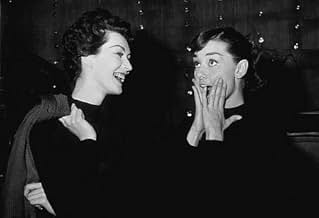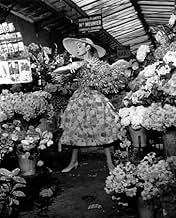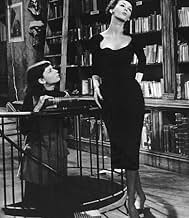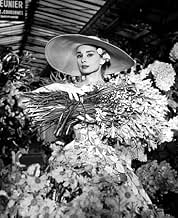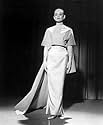CALIFICACIÓN DE IMDb
7.0/10
35 k
TU CALIFICACIÓN
Un prestigioso fotógrafo de moda parisino busca a la mujer perfecta para su próximo artículo.Un prestigioso fotógrafo de moda parisino busca a la mujer perfecta para su próximo artículo.Un prestigioso fotógrafo de moda parisino busca a la mujer perfecta para su próximo artículo.
- Dirección
- Guionista
- Elenco
- Nominado a 4 premios Óscar
- 2 premios ganados y 10 nominaciones en total
Heather Ames
- Junior Editor
- (sin créditos)
Fern Barry
- Southern Wife
- (sin créditos)
Brandon Beach
- Fashion Show Guest
- (sin créditos)
Paul Bisciglia
- Photographer
- (sin créditos)
- Dirección
- Guionista
- Todo el elenco y el equipo
- Producción, taquilla y más en IMDbPro
Opiniones destacadas
This 1957 musical is a little odd. It has a title based on an original 1920s Gershwin musical (that included the title song) which starred Fred and Adele Astaire. It was a musical and scenic valentine to France (but only one tune in it deals with France - "Bonjour Paris!". It is a spoof on the modern fashion magazines, fashions in general, and advertising - but the spoof while sharp at times is never pushed. The opening sequence, "Think Pink," describes how Kay Thompson plans a campaign to make the American woman go for "pink" clothes, accessories, toothpaste, etc., only to admit to her assistant she personally loathes the color. It takes full advantage of the attractive face and features of Hepburn, who is convinced to be a model and help push a new line of fashions in Paris. And it makes two characters into imitations of Richard Avedon the photographer (Astaire as Dick Avory) and Jean-Paul Sartre (Michel Auclair as Prof. Emile Flostre).
Avedon was a rarity - a fashion photographer who became a great artistic portrait photographer. Astaire never is shown taking pictures of great or famous people in the film but several times he demonstrates a refinement that separates him from the rest of Kay Thompson's entourage (most of whom don't care what havoc they cause, as long as they get their jobs done). He also has enough sense to question Hepburn's accepting of "empathicalism", and it's viability. Witness his moment in the bistro pouring wine to the two old codgers who are quite pleasant to him while he insults them in English. Hepburn, of course, is so insistent on the validity of her philosophical beliefs that she rejects Astaire's warnings, and jeopardizes the fashion show.
The final blow (seemingly) to the Astaire - Hepburn relationship is when he confronts Flostre at the author's home. He knocks out the Professor, and his brutality demolishes the relationship with Hepburn. But within minutes Hepburn sees another side to Flostre which is unexpected, and suddenly realizes that Astaire may be right after all.
The character of Flostre is obviously based on that of Jean-Paul Sartre, the founder of "existentialism". Based on in some details, but not in theory. "Empathicalism" has to do with trying to empathize with others so as to have a proper response to their needs and aspirations. "Existentialism" has to do with: "An introspective humanism or theory of man which expresses the individual's intense awareness of his contingency and freedom; a theory which states that the existence of the individual precedes his essence." This is from Webster's New Collegiate Dictionary. Sartre has a more complex view of man and society, and one can plow through BEING AND NOTHINGNESS to try to understand it. In fact some critics have wondered if the Nobel Prize Winner eventually got very wrong headed about his theory. But he certainly seems a meatier philosopher than his celluloid copy.
But Flostre does have the trappings of Sartre on him. He is revered by his followers world wide (such as Hepburn). He is a man with sexual appetite (as Sartre was with his long time companion and fellow writer Simone Beauvoir). And there is some traces of an anti-capitalist, even anti-American attitude in him. It is not definitely pushed, but when Astaire and Thompson break into his house during a party, they pretend they are American share cropper singers whom Flostre had brought to France to perform for his guests. Now, we never hear what this actual pair actually would sing, but judging from their background they would have to throw in some protest songs. Sartre was very critical of the U.S.A. and capitalism (today his fans have to explain Sartre's willingness to accept Russian imperialist moves under Communism in the 1940s, 1950s, and 1960s - they find it very hard to do so).
On the whole the parts of the film work well, so I give it seven stars. Kay Thompson is best recalled for being the creator of the little girl at the Plaza "Eloise", but she shows here a highly entertaining performance as Maggie Prescott, the editor who pushes and loathes pink. The film would have been better if somehow Avedon's portrait photography had been brought into the story, possibly in a final scene with Flostre as his subject. However, even without such a sequence the film is rewarding to watch, especially in the musical numbers. Astaire does equally well with Thompson and with Hepburn as his partners here.
Avedon was a rarity - a fashion photographer who became a great artistic portrait photographer. Astaire never is shown taking pictures of great or famous people in the film but several times he demonstrates a refinement that separates him from the rest of Kay Thompson's entourage (most of whom don't care what havoc they cause, as long as they get their jobs done). He also has enough sense to question Hepburn's accepting of "empathicalism", and it's viability. Witness his moment in the bistro pouring wine to the two old codgers who are quite pleasant to him while he insults them in English. Hepburn, of course, is so insistent on the validity of her philosophical beliefs that she rejects Astaire's warnings, and jeopardizes the fashion show.
The final blow (seemingly) to the Astaire - Hepburn relationship is when he confronts Flostre at the author's home. He knocks out the Professor, and his brutality demolishes the relationship with Hepburn. But within minutes Hepburn sees another side to Flostre which is unexpected, and suddenly realizes that Astaire may be right after all.
The character of Flostre is obviously based on that of Jean-Paul Sartre, the founder of "existentialism". Based on in some details, but not in theory. "Empathicalism" has to do with trying to empathize with others so as to have a proper response to their needs and aspirations. "Existentialism" has to do with: "An introspective humanism or theory of man which expresses the individual's intense awareness of his contingency and freedom; a theory which states that the existence of the individual precedes his essence." This is from Webster's New Collegiate Dictionary. Sartre has a more complex view of man and society, and one can plow through BEING AND NOTHINGNESS to try to understand it. In fact some critics have wondered if the Nobel Prize Winner eventually got very wrong headed about his theory. But he certainly seems a meatier philosopher than his celluloid copy.
But Flostre does have the trappings of Sartre on him. He is revered by his followers world wide (such as Hepburn). He is a man with sexual appetite (as Sartre was with his long time companion and fellow writer Simone Beauvoir). And there is some traces of an anti-capitalist, even anti-American attitude in him. It is not definitely pushed, but when Astaire and Thompson break into his house during a party, they pretend they are American share cropper singers whom Flostre had brought to France to perform for his guests. Now, we never hear what this actual pair actually would sing, but judging from their background they would have to throw in some protest songs. Sartre was very critical of the U.S.A. and capitalism (today his fans have to explain Sartre's willingness to accept Russian imperialist moves under Communism in the 1940s, 1950s, and 1960s - they find it very hard to do so).
On the whole the parts of the film work well, so I give it seven stars. Kay Thompson is best recalled for being the creator of the little girl at the Plaza "Eloise", but she shows here a highly entertaining performance as Maggie Prescott, the editor who pushes and loathes pink. The film would have been better if somehow Avedon's portrait photography had been brought into the story, possibly in a final scene with Flostre as his subject. However, even without such a sequence the film is rewarding to watch, especially in the musical numbers. Astaire does equally well with Thompson and with Hepburn as his partners here.
The bookshop salesgirl Jo Stockton (Audrey Hepburn) is accidentally found by the photograph Dick Avery (Fred Astaire), who convinces the owner of the fashion magazine Quality, the powerful Maggie Prescott (Kay Thompson), that she could be the new model she wants for the magazine. Jo dreams on going to Paris to meet her guru, the philosopher Prof. Emile Flostre (Michel Auclair), but she cannot afford to pay for the travel; therefore she sees in the invitation, the chance to visit Paris. Once there, Dick falls in love for her.
"Funny Face" has a great cinematography, art direction, set decoration, costume design and most important, a charming and delightful Audrey Hepburn. Kay Thompson is also excellent. The problem is the silly screenplay that shows at least two great mistakes. The first one is the inconsistent and contradictory character Jo Stockton, presented as an intelligent and clever woman in the beginning, but later becoming absolutely shallow, acting like an irresponsible spoiled child. The second big mistake is Fred Astaire (58), thirty years old older than Audrey Hepburn (28), therefore more than twice her age, as her romantic pair. This great actor looks like her father, and there is no romantic chemistry between them. My vote is seven.
Title (Brazil): "Cinderela em Paris" ("Cinderella in Paris")
"Funny Face" has a great cinematography, art direction, set decoration, costume design and most important, a charming and delightful Audrey Hepburn. Kay Thompson is also excellent. The problem is the silly screenplay that shows at least two great mistakes. The first one is the inconsistent and contradictory character Jo Stockton, presented as an intelligent and clever woman in the beginning, but later becoming absolutely shallow, acting like an irresponsible spoiled child. The second big mistake is Fred Astaire (58), thirty years old older than Audrey Hepburn (28), therefore more than twice her age, as her romantic pair. This great actor looks like her father, and there is no romantic chemistry between them. My vote is seven.
Title (Brazil): "Cinderela em Paris" ("Cinderella in Paris")
The first of two films released in 1957 in which Fred Astaire effectively bade farewell to the genre he had bestrode like a colossus for nearly a quarter of a century is the cinematic equivalent of gorging yourself on a box of chocolates without the calories.
The title photographs by Richard Avedon (on whom the character played by Astaire was based) establish the iconic fifties cool that never lets up for the rest of the film. Had they shot the whole thing in the studio, the Gershwin score, Technicolor, VistaVision and Edith Head creations worn by all the cast but Audrey Hepburn would already have induced pleasure overload. But producer Roger Edens also shipped the crew to Paris and whipped that into the brew.
It shows how spoiled they were in those days that it didn't collect a single Oscar.
The title photographs by Richard Avedon (on whom the character played by Astaire was based) establish the iconic fifties cool that never lets up for the rest of the film. Had they shot the whole thing in the studio, the Gershwin score, Technicolor, VistaVision and Edith Head creations worn by all the cast but Audrey Hepburn would already have induced pleasure overload. But producer Roger Edens also shipped the crew to Paris and whipped that into the brew.
It shows how spoiled they were in those days that it didn't collect a single Oscar.
Outstanding. Beautiful. Classic. What a real lady!!!
The photo sequence in Paris has never been topped. Such a 10+ movie, I can just watch it over and over. Those are kind of strange adjectives and comments from me, especially since I'm a Sci-Fi, action, fantasy kind of movie fan.
This makes me wonder, will we ever have another Audrey?? Maybe an actress who is even close? To think that she thought she had: 1. A square face, 2. A big nose and 3. Big feet. That just shows how human and natural she really was..........
What a surprise for me to find this movie. I had never even heard of it untill it came out on DVD. S'Marvelous!!
The photo sequence in Paris has never been topped. Such a 10+ movie, I can just watch it over and over. Those are kind of strange adjectives and comments from me, especially since I'm a Sci-Fi, action, fantasy kind of movie fan.
This makes me wonder, will we ever have another Audrey?? Maybe an actress who is even close? To think that she thought she had: 1. A square face, 2. A big nose and 3. Big feet. That just shows how human and natural she really was..........
What a surprise for me to find this movie. I had never even heard of it untill it came out on DVD. S'Marvelous!!
Stanley Donen's "Funny Face" was one of the best musicals that came out of Paramount, a studio not known for that genre. The DVD format we watched recently seems to have been transferred with great care as the colors have a vibrant look, something that wasn't the case with the technique used during that era that made colors fade.
The film owes its appeal to Audrey Hepburn, an actress not known for being a singer, or a dancer, but who had enough charm to make the movie her own. The pairing with the great Fred Astaire pays off well because Mr. Astaire was always an actor who had enough chemistry with his leading ladies. Ms. Hepburn's costumes by Givenchy and the way she carries herself in them is one of the best assets about "Funny Face".
The other surprise of the movie is Kay Thompson, who plays the magazine editor Maggie Prescott. Ms. Thompson makes an excellent contribution to the film as the no nonsense woman who ruled what the fashions of the day should be as shown in the pages of the magazine.
The songs of George Gershwin are complimented by the original music composed for the musical by Roger Edens, Adolph Deutsch and Leonard Gershe. The great cinematography of Ray June shows Paris at its best. Thanks to Stanley Donen all the elements feel into place and we were left with this musical that will delight audiences forever.
The film owes its appeal to Audrey Hepburn, an actress not known for being a singer, or a dancer, but who had enough charm to make the movie her own. The pairing with the great Fred Astaire pays off well because Mr. Astaire was always an actor who had enough chemistry with his leading ladies. Ms. Hepburn's costumes by Givenchy and the way she carries herself in them is one of the best assets about "Funny Face".
The other surprise of the movie is Kay Thompson, who plays the magazine editor Maggie Prescott. Ms. Thompson makes an excellent contribution to the film as the no nonsense woman who ruled what the fashions of the day should be as shown in the pages of the magazine.
The songs of George Gershwin are complimented by the original music composed for the musical by Roger Edens, Adolph Deutsch and Leonard Gershe. The great cinematography of Ray June shows Paris at its best. Thanks to Stanley Donen all the elements feel into place and we were left with this musical that will delight audiences forever.
¿Sabías que…?
- TriviaFred Astaire's character is based on photographer Richard Avedon and his wife, Doe, who, like the character "Jo Stockton," became a noted model despite her indifference toward that profession. In fact, it is Avedon who set up most of the photography for this film, including the famous face portrait of Audrey Hepburn unveiled during the darkroom sequence.
- ErroresAfter Dick kisses Jo and leaves the bookstore, Jo begins to sing "How Long Has This Been Going On". As she sings to herself while looking at the mirror in the supposedly empty bookstore, someone is reflected in the mirror moving around on the second floor of the bookstore.
- Citas
Dick Avery: When I get through with you, you'll look like... What do you call beautiful? A tree. You'll look like a tree.
- Créditos curiososThe opening credits, designed by film consultant Richard Avedon, consist of traditional film credit display interspersed with live action, fashion models and photographic film.
- ConexionesEdited into Chop Suey (2001)
- Bandas sonorasOverture: Funny Face/'S Wonderful/Think Pink!
(uncredited)
Lyrics by Ira Gershwin
Music by George Gershwin
Performed by Fred Astaire
Selecciones populares
Inicia sesión para calificar y agrega a la lista de videos para obtener recomendaciones personalizadas
Detalles
- Fecha de lanzamiento
- País de origen
- Idiomas
- También se conoce como
- Funny Face
- Locaciones de filmación
- Château de la reine blanche, Coye-la-Forêt, Oise, Francia(wedding dress photo shoot, Dick's marriage proposal)
- Productora
- Ver más créditos de la compañía en IMDbPro
Taquilla
- Presupuesto
- USD 3,000,000 (estimado)
- Total a nivel mundial
- USD 1,669
- Tiempo de ejecución1 hora 43 minutos
- Color
- Relación de aspecto
- 1.85 : 1
Contribuir a esta página
Sugiere una edición o agrega el contenido que falta







